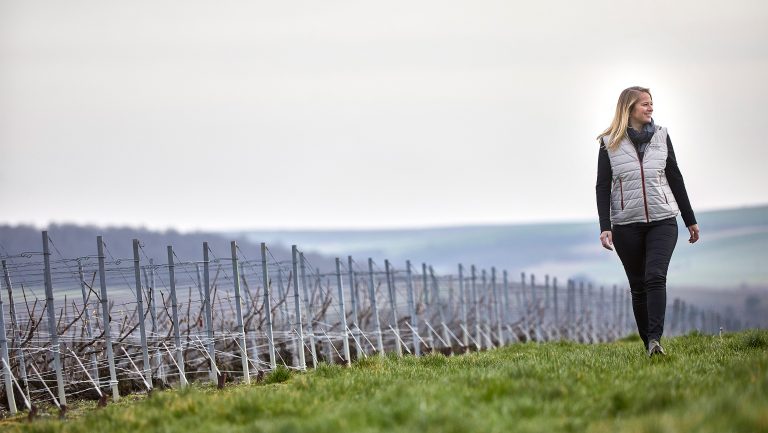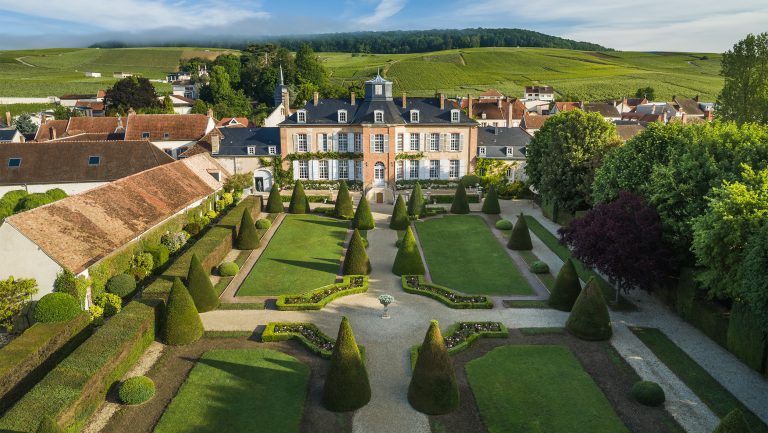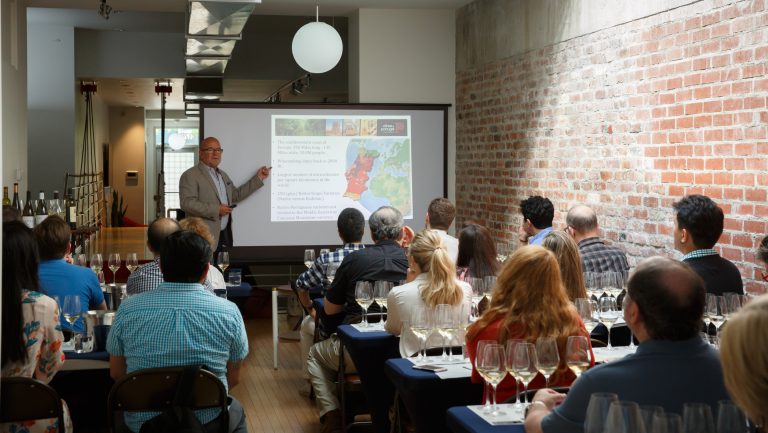This advertising content was produced in collaboration with our partner, Maisons & Domaines Henriot America.
More than 200 years ago in Reims, newly widowed Apolline Henriot paged through a slim volume called How to Manage a Vineyard and Make Wine in the Champagne Region. The book—which has since been acknowledged as one of the first works of wine literature—was written by her great-uncle, a monk named Chanoine Jean Godinot. Both her uncle and her late husband, Nicolas Henriot, had been amateur winegrowers who relished experimenting in the cellar. Now, it was Apolline’s turn to make great wine.
Armed with the instructional guide and an uncommonly enterprising spirit, Apolline set out to launch what would become one of Champagne’s most celebrated and lasting story. With her label Veuve Henriot Ainé—which would later become Champagne Henriot—she aimed to “shed light on the beauty of her land.”
Today, centuries later, Champagne Henriot remains family-owned and woman-led, featuring wines crafted by cellar master Alice Tétienne—and each one tells a bit of the story of how Henriot’s vineyards evolved from the house’s founding until today. Even in the face of daunting environmental challenges, Tétienne is committed to maintaining the integrity of each bottle and ensuring that Apolline’s light shines ever brightly.

Don’t miss the latest drinks industry news and insights. Sign up for our award-winning newsletters and get insider intel, resources, and trends delivered to your inbox every week.
Telling a Story Through Wines
Born and raised in Champagne, Tétienne has a personal connection to Henriot, as her grandmother owned a vineyard adjacent to one of Apolline’s original vineyards in the Montagne de Reims. An extraordinarily accomplished winemaker with a strong viticultural background, she previously held positions at Maison Krug and Centre Vinicole Nicolas Feuillatte; she was also awarded the “Best Winemaker of the Year” title in 2020 by Trophées Champenois. Since assuming the role of Champagne Henriot Cellar Master in 2020, she has wholeheartedly embraced carrying forth the Henriot family’s legacy.
And what a legacy it is: Since their first bottling, Henriot wines have won wide acclaim, including praise from nobility across Europe. With every pivotal point in the company history, a new wine was born and a new story was written. “Our goal,” says Alice, “is to perpetuate that story.”
For instance, the Brut Souverain, a blend of all of the house’s vineyards, is a formulation derived from the inaugural wine created by Apolline Henriot. Now sourced from 26 different crus and multiple vintages, including a reserve wine dating back to 1969, this foundational wine beautifully encompasses the house’s 200-year history and Apolline’s vision to shine a light on all of her vineyards while showcasing the art of blending for which Champagne is renowned.
In 1880, the family’s holdings expanded when Apolline’s great-grandson married Marie Marguet, whose dowry included prime parcels of Chardonnay that expanded the family’s vineyards into the Côte de Blancs. This contribution of Henriot’s first Chardonnay vines is highlighted in the multi-vintage Henriot Blanc de Blancs, sourced from all of the house’s Côte des Blancs vineyards—in total, 12 different crus, including some of the vineyards Marguet brought to the house over a century ago.
The Hemera 2006 is named for the Greek goddess of the daytime, or light. This is a fitting name, as Apolline intended to “shed light on the land” with her wines. Made from a blend of the six founding crus of Henriot—three from Apolline and three from Marguet—it has been crafted since the late 19th century, shortly after the Côte des Blancs vineyards joined the house. Previously known as Cuvée des Enchanteleurs and Baccarat, it sees a minimum of 13 years of aging on the lees to craft spectacular complexity, longevity, and elegance. With the elegance of Verzenay, the elegance of Chouilly, and so much more, this wine showcases the history of Henriot and the range of the Champagne region in a single bottle.
Today, Champagne Henriot harvests 20 percent of its fruit from estate-owned properties, sourcing the remaining 80 percent from winegrowers they have built a long time relationship with, sometimes over several generations. The family has also taken its vision beyond the region of Champagne; it was the first from Champagne to venture into Burgundy in the mid-1990s, taking over the legacy of the Bouchard family and William Fèvre, who also focused on high-quality vineyards.
Adapting for the Future
Despite the successes of Henriot, its challenges cannot be denied. In recent years, extreme weather events have disrupted winegrowing in Champagne and around the world. A turning point came in 2012, when long bouts of snow, frost, and hail traumatized the vineyards. The vines ultimately prevailed, yielding a crop of high-quality fruit, some of which would ultimately become the Millésime 2012, which was recently released.
After the strife of the growing season, the wine itself was an unexpected victory, a blend of 54 percent Chardonnay and 46 percent Pinot Noir. It’s a vintage that Tétienne describes as aromatically complex, with plenty of contrast and elegance.
Now, Champagne Henriot has put adapting to climate change at the forefront. “Climate change,” says Tétienne, “is our first priority. We see extremes in the weather. We see that we need to change our viticulture and to adapt it to the changes. First, we need to understand and know our soils and vineyards deeply. Then we need to be able to survive with climate change and its impact on the vineyard and the grapes.”
In response to the threat of a rapidly warming planet, Champagne Henriot has proactively reassessed their practices and methodology. Under the leadership of both Tétienne and eighth-generation family president and CEO Gilles de Larouzière, the house has earned a range of environmental certifications, including Haute Valeur Environnementale (HVE) and Viticulture Durable en Champagne (VDC). This paperwork, however, is just the beginning.
“To be [certified] organic is not enough,” says Tétienne. “We need to be present and observe nature. We need other ways to pay attention to the environment.” Working with the Champagne community and winegrower partners to anticipate and manage change, she says, is key.
The team at Champagne Henriot is united in their conviction that caring for its land and vines will manifest in the wines themselves and result in higher precision. The company motto has become, “The wine is written in the vines.”
For her part, Tétienne intends to make that story a memorable one.

Dispatch
Sign up for our award-winning newsletter
Don’t miss the latest drinks industry news and insights—delivered to your inbox every week.










